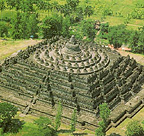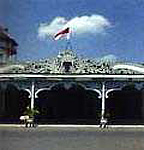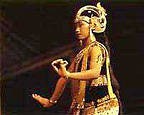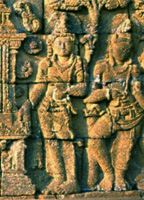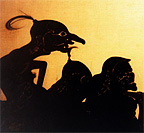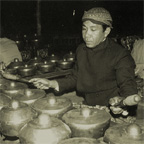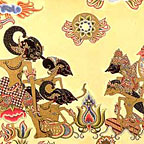|
Semarang
In size and inhabitants, Semarang falls under the five major cities
in the nation. It is situated on Java's normally flat northern coast
and appropriately called the capital of Central Java as it lies
just about halfway between the two extreme east and west coasts
of the island. Indeed, few cities in the country have got hills
and mountains so clearly visible from their seaports.
In fact, mostly residential, Candi is a hill within Semarang's perimeter
from where breathtaking panoramas on all directions can be witnessed
the port, the lowlands and green paddy fields,the city itself and
the numerous mountains.
The proximity of all this beauty promises adventurous car trips
out of Semarang offering you memorable experiences and to be back
in the city before dark.
There is an older part of the city, close to its ocean harbour,
where you can still find an interesting collection of odd-looking
buildings dating back to the Dutch colonial era and further back
still, to the time of the Dutch East Indies Company. And finally
the city's zoo, may also be worth while visiting.
More up to date, the city offers evening performances of Wayang
drama played by live actors, actresses and dancers at Ngesti Pandowo
Theatre. For sport fans there are tennis courts in all major hotels
and 2 golf courses located in the town's suburbs.
Sangiran, The Land of Mystery
Located 15 kms from Surakarta. It is a fossilizes land of prehistoric
living things. In 1891, Eugene Dubois, a French anthropologist discovered
fossils of Phitecantropus Erectus, the oldest Java man known. Again
in 1930 and 1931, Ngandong Village, Trinil-Mojokerto, was marked
with the discovery of fossils of a man that belonged to the Pleistocene
Period. It revealed human history from many centuries ago.
Prof. Dr. Van Koenigswald in 1936 found more evidence about human
evolution. He discovered some fossils that support the theory of
human growth from an apeman to be man as we are now.
Other fossils, which include those of mammoths (pre historic elephant)
are now preserved in Bandung Geological Museum. In mid 1980, scientists
were started by the finding of a complete 4 m tall elephant.
Jepara
northeast of Semarang, is a town with white sandy beaches around
it, and is also famous for its wood carving industry. Most artists
of this sophisticated art come from around this area. It is also
the birthplace of Indonesia's heroine of the national women's liberation
movement.
An ancient Portuguese Fort can be found to the east of Jepara. Along
the road from Semarang to this town are many sights and curiosities
worthy of seeing.
Kudus
about halfway between Jepara and Semarang, could be taken in on
the same trip, as well as Demak. So, Kudus and Demak are two towns
having the same directions as to Jepara, and both have historical
significance. Kudus has the Minaret Mosque which was built in the
1 5th century, whereas Demak has the oldest mosque in Central Java,
both of them very interesting structures from the architectural
point of view.
Other places of interest are either south, southwest or west of
Semarang which are usually not visited on one roundtrip out of Semarang.
It is recommended that you leave the capital on a toure to another
city, say, Solo, and see the beautiful things along the way. But
even then, you may not be able to see them all in one single day.
Another point of destination would be necessary to see other places
of interest.
It is advisable that you study a detailed map of Central Java to
pinpoint the places you want to visit, which very much depend on
your personal taste and interest.
Ambarawa Railway Museum
Fifty kms, south of Semarang, Ambarawa is the home of Java'` antique
locomotive, Established into a museum, it has locomotives of various
types and ages, and it is still possible to ride or a cog railway
between Ambarawa and Bedono, a village nearby Prior arrangements
should be made for groups.
Also of interest are a collection of antique telephones and other
instruments used for railway communication.
Solo
A medium size city with a lively character, Solo is also called
the city that never sleeps. From the evening throughout the whole
night one can always find something to eat or buy, as vendors of
all kinds as well as small foodstalls remain active and open 24
hours. Home of two royal houses with centuries of power and influence
over the city, Solo today remains distinctly Central Javanese with
an elegance of its own. It is one of the major centres of batik
cloths and other Javanese fabrics, whereas souvenir hunters may
find exquisite "objects d'art" and very ornate trinkets
and other decorative items. Those interested in old Javanese culture
and art should not miss Solo on their itinerary, as the royal palaces
including relics of all sorts will be all yours to witness. Once
in Solo which offers excellent accommodation, short trips to its
surrounding areas can easily be made by car or coach. Most hotels
should have a stock of pamphlets and booklets on all interesting
sport and items available.
Not far from here is the Sukuh Temple with wayang stone carvings
of Hindu origin and which is the only sample of an erotic temple
in Java having the shape of a stepped pyramid like the ones in South
America of the Maya culture. There are also a two-century old palace
of King Pakubuwono, art Gallery exhibiting Royal heirlooms, various
Javanese weapons, antiques and other invaluable items.
Tawangmangu
Some of the places of interest are for instance Tawangmangu, a mountain
resort at an elevation of almost 1 km above sea level which promises
you a cool escape from the city's heat.
Located 40 kms east of Solo. It lies on the slope of mount Lawu,
at an elevation of 1300 m above sea level. It is a recreational
resort offering fiesh weather, scenic views, swimming pools, bungalow
style hotels and restaurants.
Other features include nearby temples in ruin, a national park and
the 40 m high waterfall of Grojogan Sewu.
Kasunanan Palace
A 17th century palace, the royal residence of King Pakubuwono. Attached
to the palace is an art gallery exhibiting royal heirlooms, antiques
and other invaluable objects. A genuine royal Javanese atmosphere
can be felt and enjoyed here.
Mangkunegaran Palace or Pura Mangkunegaran
Another palace built 1757, with a typical Javanese architecture
consisting of "Pendopo" (an open front hall to receive
guests), "Pringgitan" (an porch to hold leather puppet
shadow play) and private apartments. Two sets of 17th century Javanese
gamelan instruments are exhibited and played every Wednesdays in
the pendopo. The palace also exhibits complete collection of masks,
wayang orang costumes, leather and wooden puppets, religious articles,
jewelries, et
Another palace is the royal residence of Prince Mangkunegoro, featuring
typical Javanese architecture, a complete collection of masks, heirlooms,
wayang golek, handicrafts, Javanese musical instruments and superb
antiques are axhibited here.
Bandungan and Gedong Songo Temple
This is a holiday resort on the slope of Mt. Ungaran, about 900
meters above sea level. Gedong Songo (nine buildings!, a group of
small 8th century Hindu Javanese temples, can be reached either
by car or on horseback from the town. Built at about the same time
as the temples of the Dieng complex, Gedong Songo is one of the
most beautifully sited temple complexes in Central Java and the
views alone are worth the trip.
Borobudur Temple
The name "Borobudur" is believed to have been derived
from the Sanskrit words "Vihara Buddha Uhr" the Buddhist
Monastery on the hill. The Borobudur Temple was built in the eighth
century by the Cailendra dynasty and is located at Magelang 90 km
southeast of Semarang or 42 km northwest of Yogyakarta. Visitor
have the option of going by taxi or public bus to reach this temple.
One of the world's most famous temples, it stand majestically on
a hillock overlooking lush green field and distant hills.
Borobudur is built of grey andesite stone. It rises to seven terraces,
each smaller than the one below it. The top is the Great Stupa,
standing 40 meters above the ground. The walls of the Borobudur
are sculptured in bas-relief extending over a total length of six
kilometres. It has been hailed as the largest and most complete
ensemble of Buddhist reliefs in the world, unsurpassed in artistic
merit, each scene an individual masterpiece.
The monument has been completely restored and was officially opened
by the President on 23 February 1983. The restoration took eight
years to complete, funded by the Government of Indonesia with aid
from UNESCO and donations from private citizens as well as from
foreign governments.
The Borobudur was in danger of collapsing its stone statues and
bas-relichs affected by stone cancer, moss and lichen. A large parking
area is available not far from the monument, so private cars and
buses have to be parked in this area. During the Buddhist festival
of Waisak in May, processions start from Mendut temple. Public transportation
is available the bus terminal. From that point visitors can hire
becaks or horse carts, or walk the rest of the way to the monument.
Mendut Temple
Located only three kilometers from Borobudur, Mendut is said to
face toward Benares, India, where Buddha Gautama taught his five
disclipes the very first time. The smaller temples of Mendut, which
houses the great statue of Buddha and the Pawon temple, form an
integral part of the Borobudur complex. The three-metre tall Buddha
together with the two Bodhisatva figures of Lokesvara and Vajrapani
are in the view of some experts, among the greatest manifestations
of Buddhist thought and art. Through these smaller temple complexes
the pilgrim must pass before ascending the great Borobudur monument.
Jatijajar Cave
Jatijajar Cave is about 49 km west of Kebumen, or 20 km from Gombong.
It is the most interesting cave in Central Java with its stalactite
and stalagmite. Inside, there is Kamandaka statue which has its
own legend. Krakal hot water-springs is located 13 km north-east
of Kebumen. Bathing rooms are available. Like many other hot water-springs,
it is an effective remedy for skin diseases. 3 km north of Gombong,
is the Sempor Dam surrounded by hills forming a nice mountain scenery.
Recreational facilities are also provided here.
Goa Lawa
Goa Lawa is cave on the foot of Mt. Slamet, 27 km to the north of
Purbolinggo. Located 900 metre above sea level, the air is naturally
cool and it offers panoramic, mountain view.
Baturaden
Central Java's outstanding resort, approximately 1 4 kms north of
Purwokerto. It occupies a fine site on the slope of Mount Slamet,
at an elevation of 650 m above sea level. It has remarkable weather
with a cool mountain breeze. The temperature ranges from 18_C to
25_C. The resort area is surrounded by nice gardens, hot springs,
ponds and bungalow-style hotels abound. Other features included
200 ha pine forest, a nearby market and marvelous views.
Dieng Plateau
Four hours from Semarang is the Dieng Plateau. Here are found some
of the oldest Hindu temples of Java.
These small monuments which are not more than 50 feet high stand
on a crater floor amidst sulphurous fumes and a shrugged majesty,
underlined by the presence of a few of the starkest Shivaite temples
at an elevation of more than 6.000 feet, is impressive. The road
to the Dieng Plateau passes through tobacco plantations and beautiful
mountain scenery.
Karimunjawa's Marine Life
The archipelagic Karimunjawa, thought not as known the Marine reserves
near Ambon and Manado, has unexpectedly good beaches, reefs and
lovely sea scapes. Corals seem to blossom in to gardens, with an
Amazing variety of form and colour fishers and marine plants. Karimunjawa
consist of 27 island and only a few of which are inhabited. It lies
90 kms away from Jepara and can reached by "KM. Adison I &
KM Kota Ukir" boat, the only ferryboat connecting Karimunjawa
and Jepara.
Curug Sewu
It is situated at Patean sub district Sukorejo about 41 km from
Kendall To visit it, visitors can take public buses on route Semarang
- Kendal - Weleri - Sukorejo. It can also be reached from the southern
part of the province, via Wonosobo / Temanggung on route to Parakan
- Ngadirejo - Candroto - Patean. It is the highest waterfall in
the province with three levels. The highs are 45 metres, 15 metres
and 20 metres. Visitors can en joy walking along the forest near
the waterfall and also enjoying the forest near the waterfall and
also enjoying the mountainous part of the forest called "Lintas
Hutan Indah".
Guci Hot Water Spring
It is about 19 kilometres away from Tegal southward. Guci is a mountain
resort at the height of 1,050 metres above sea level with the temperature
ranging from 12.8_ to 21.9_. The main point of interest is the hot
water spring. You can take a bath in either indoor and outdoor bathing
place or the swimming pool. The water contains chemical compound
such as zinc, sulphure, iodine. Therefore, it can cure various kinds
of skin deceases.
The Guci Hot Water Spring is also provided with facilities to meet
the tourists requirement such as hotel, restaurants, conference
room, children play ground, camping site, parking lot, ect.
Taman Kyai Langgeng
Kyai Langgeng Park located at the western part of
Magelang and occupying land of about 19 hectares functions not only
as a means. The park with the tranquility of rural atmosphere is
easily accessible as it lies only about 1 km from the centre of
the town. Convenient public transports bring you there, leaving
the business of town life to go back to nature.
Built by the Local Government of Magelang Municipality and opened
its gate to the public in 1987, Kyai Langgeng Park is now providing
you with,:
Collection of many kinds of rare plants from all over Indonesia,
collection of dinosaurs statues, fishing pond, traffic gardens,
aquariums green house, swimming pool, open air theatre, large cages
of various kinds of tropical birds, various kinds of animals from
the bigger to the smaller ones, arena for go carting, a river for
canoing and wild water surfing, restaurants, souvenir shops, tropical
fruit market, indoor tennis court, hotel and many other things to
see, to do and to en joy.
This park is named after the name of one of the followers of Prince
Diponegoro, one of the Indonesian heroes who fought bravely againts
the Dutch Colonialist during Diponegoro's war (1825-1830). The late
Kyai Langgeng was buried in this area and his burial can still be
found here.
For now and the future the Local Government of Magelang Municipality
will keep on the move to invest new things in the frame of providing
recreational facilities for all levels of the community.
|











